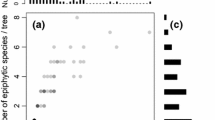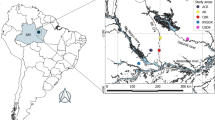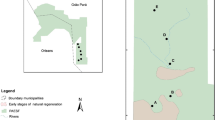Abstract
We conducted a comprehensive census of the vascular epiphytes in a lowland forest in Panama by means of a canopy crane. In 0.4 ha of ca. 40-m tall forest, 103 species of vascular epiphytes with 13,099 individuals were found. The orchids were the most important family both in species and individual numbers, accounting alone for >40% of all species and >50% of all individuals. There was a clear vertical segregation of species with a concentration at intermediate heights: more than 50% of all individuals were found between 15 m and 25 m above ground. Tree species identity, tree size and the position of a tree in the forest (“space”) all influenced species composition. However, none of the two environmental variables nor space alone explained more than 10% of the total variation in epiphyte assemblages in several canonical correspondence analyses. By far the largest proportion of the observed variation remained unexplained and is arguably due to mere chance. In the future, our results will be used as a baseline data-set for the direct observation of the long-term dynamics in a diverse epiphyte community.



Similar content being viewed by others
References
Balslev H, Valencia R, Paz y Miño G, Christensen H, Nielsen I (1998) Species count of vascular plants in one hectare of humid lowland forest in Amazonian Ecuador. In: Dallmeier F, Comiskey JA (eds) Forest biodiversity in North, Central and South America, and the Caribbean. Man and the Biosphere 21. Parthenon Publishing Group, Paris, pp 585–594
Benavides A-M, Duque AJ, Duivenvoorden JF, Vasco GA, Callejas R (2005) A first quantitative census of vascular epiphytes in rain forests of Colombian Amazonia. Biodivers Conserv 14:739–758
Benzing DH (1990) Vascular epiphytes. General biology and related biota. Cambridge University Press, Cambridge
Bernal R, Valverde T, Hernandez-Rosas L. (2005) Habitat preference of the epiphyte Tillandsia recurvata (Bromeliaceae) in a semi-desert environment in Central Mexico. Can J Bot 83:1238–1247
Borcard D, Legendre P, Drapeau P (1992) Partialling out the spatial component of ecological variation. Ecology 73:1045–1055
Borcard D, Legendre P (2004) SpaceMaker2 – User’s guide. Montreal, Université de Montréal, Département de sciences biologiques. Available from the web site <http://www.fas.umontreal.ca/biol/legendre/>
Bordenave BG, de Granville J-J, Hoff M (1998) Measurements of species richness of vascular plants in a neotropical rain forest in French Guiana. In: Dallmeier F, Comiskey JA (eds) Forest biodiversity in North, Central and South America, and the Caribbean. Man and the Biosphere 21. Parthenon Publishing Group, Paris, pp 411–425
Croat TB (1978) Flora of Barro Colorado Island. Stanford University Press, Stanford
D'Arcy WG (1987) Flora of Panama: checklist and index. Missouri Botanical Garden, St Louis
Dressler RL (1993) Field guide to the orchids of Costa Rica and Panama. Cornell University Press, Ithaka, NY
Flores-Palacios A, García-Franco JG (2006) The relationship between tree size and epiphyte species richness: testing four different hypotheses. J Biogeogr 33:323–330
Freiberg M (1996) Spatial distribution of vascular epiphytes on three emergent canopy trees in French Guiana. Biotropica 28:345–355
Freiberg M (1999) The vascular epiphytes on a Virola michelii tree (Myristicaceae) in French Guiana. Ecotropica 5:75–81
Galeano G, Suárez S, Balslev H (1999) Vascular plant species count in a wet forest in the Chocó area on the Pacific coast of Colombia. Biodivers Conserv 7:1563–1575
Gentry AH, Dodson CH (1987) Contribution of non-trees to species richness of a tropical rain forest. Biotropica 19:149–156
Harms KE, Condit R, Hubbell SP, Foster RB (2001) Habitat associations of trees and shrubs in a 50-ha neotropical forest plot. J Ecol 89:947
Harms KE, Wright SJ, Calderón O, Hernandez A, Herre EA (2000) Pervasive density-dependent recruitment enhances seedling diversity in a tropical forest. Nature 404:493–495
Hietz P, Ausserer J, Schindler G (2002) Growth, maturation and survival of epiphytic bromeliads in a Mexican humid montane forest. J Trop Ecol 18:177–191
Hietz P, Hietz-Seifert U (1995) Intra- and interpecific relations within an epiphyte community in a mexican humid montane forest. Selbyana 16:135–140
Hubbell SP (2001) The unified neutral theory of biodiversity and biogeography. Princeton University Press, Princeton
Hubbell SP, Foster RB, O’Brien ST, Harms KE, Condit R, Wechsler B, Wright SJ, de Lao SL (1999) Light-gap disturbances, recruitment limitation, and tree diversity in a neotropical forest. Science 283:554–557
Johansson D (1974) Ecology of vascular epiphytes in West African rain forest. Acta Phytogeogr Suec 59:1–136
Kelly DL, O’Donovan G, Feehan J, Murphy S, Drangeid SO, Marcano-Berti L. (2004) The epiphyte communities of a montane rain forest in the Andes of Venezuela: patterns in the distribution of the flora. J Trop Ecol 20:643–666
Kreft H, Köster N, Küper W, Nieder J, Barthlott W (2004) Diversity and biogeography of vascular epiphytes in Western Amazonia, Yasuní, Ecuador. J Biogeogr 31:1463–1476
Krömer T, Kessler M, Gradstein SR, Acebey A (2005) Diversity patterns of vascular epiphytes along an elevational gradient in the Andes. J Biogeogr 32:1799–1809
Laube S, Zotz G (2006a) Long-term changes in the epiphyte vegetation of the palm, Socratea exorrhiza. J Veg Sci 17:307–314
Laube S, Zotz G (2006b) Neither host-specific nor random: vascular epiphytes on three tree species in a Panamanian lowland forest. Ann Bot 97:1103–1114
Laube S, Zotz G (2007) A metapopulation approach to the analysis of long-term changes in the epiphyte vegetation on the host tree Annona glabra. J Veg Sci 18 (in press)
Lellinger DB (1989) The ferns and fern-allies of Costa Rica, Panama, and the Chocó (Part I: Psilotaceae through Dicksoniaceae). American Fern Society, Washington, DC
Lepš J, Šmilauer P (2003) Multivariate analysis of ecological data using CANOCO. Cambridge University Press, Cambridge
Nieder J, Engwald S, Klawun M, Barthlott W (2000) Spatial distribution of vascular epiphytes (including hemiepiphytes) in a lowland Amazonian rain forest (Surumoni Crane Plot) of Southern Venezuela. Biotropica 32:385–396
Pittendrigh CS (1948) The Bromeliad-Anopheles-Malaria complex in Trinidad. I – The Bromeliad flora. Evolution 2:58–89
Richards PW (1996) The tropical rain forest – an ecological study. Cambridge University Press, Cambridge
Rudas-L A, Prieto-C A (1998) Floristic analysis of the Amacayacu National Park in the Mocagua Island, Amazon (Colombia). Caldasia 20:142–172
Schmidt G, Zotz G (2002) Inherently slow growth in two Caribbean epiphytic species: A demographic approach. J Veg Sci 13:527–534
Schmit-Neuerburg V (2002) Dynamics of vascular epiphyte vegetation in the Venezuelan lowland rain forest of the Surumoni Crane Project. PhD-thesis, Rheinische Friedrich-Wilhelm-Universität, Bonn
Ter Steege H, Cornelissen JHC (1989) Distribution and ecology of vascular epiphytes in lowland rain forest of Guyana. Biotropica 21:331–339
Volkov I, Banavar JR, He F, Hubbell SP, Maritan A (2005) Density dependence explains tree species abundance and diversity in tropical forests. Nature 438:658–661
Went FW (1940) Soziologie der Epiphyten eines tropischen Regenwaldes. Ann Jard Bot Buitenz 50:1–98
Whitmore TC, Peralta R, Brown K (1985) Total species count in a Costa Rican tropical rain forest. J Trop Ecol 1:375–378
Wills C, Harms KE, Condit R, King D, Thompson J, He FL, Muller-Landau HC, Ashton P, Losos E, Comita L, Hubbell S, LaFrankie J, Bunyavejchewin S, Dattaraja HS, Davies S, Esufali S, Foster R, Gunatilleke N, Gunatilleke S, Hall P, Itoh A, John R, Kiratiprayoon S, de Lao SL, Massa M, Nath C, Noor MNS, Kassim AR, Sukumar R, Suresh HS, Sun IF, Tan S, Yamakura T, Zimmerman E (2006) Nonrandom processes maintain diversity in tropical forests. Science 311:527–531
Wolf JHD, Flamenco-S A (2003) Patterns in species richness and distribution of vascular epiphytes in Chiapas, Mexico. J Biogeogr 30:1689–1707
Wright SJ, Horlyck V, Basset Y, Barrios H, Bethancourt A, Bohlman SA, Gilbert GS, Goldstein G, Graham EA, Kitajima K, Lerdau MT, Meinzer FC, Ødegaard F, Reynolds DR, Roubik DW, Sakai S, Samaniego M, Sparks JP, Van Bael S, Winter K and Zotz G (2003) Tropical canopy biology program, Republic of Panama. In: Basset Y, Horlyck V and Wright SJ (eds) Studying forest canopies from above: the International Canopy Crane Network. United Nations Environmental Programme, Smithsonian Tropical Research Institute, New York, pp 137–155
Zotz G (1997) Substrate use of three epiphytic bromeliads. Ecography 20:264–270
Zotz G (2007) Johansson revisited: the spatial structure of epiphyte assemblages. J Veg Sci 18:123–130
Zotz G, Bermejo P, Dietz H (1999) The epiphyte vegetation of Annona glabra on Barro Colorado Island, Panama. J Biogeogr 26:761–776
Zotz G, Büche M (2000) The epiphytic filmy ferns of a tropical lowland forest – species occurrence and habitat preferences. Ecotropica 6:203–206
Zotz G, Vollrath B (2003) The epiphyte vegetation of the palm, Socratea exorrhiza – correlations with tree size, tree age, and bryophyte cover. J Trop Ecol 19:81–90
Acknowledgements
We appreciate the assistance of many helpers-at-the-crane: Stefan Laube, Birgit Vollrath, Pit Reichling, Monika Frank. Funds came from the Smithsonian Tropical Research Institute (STRI, Panama), the United Nations Environmental Program (UNEP), the Deutsche Forschungsgemeinschaft, the FAG, Basel, Switzerland, and the A.F.W. Schimperstiftung, Stuttgart, Germany. Thanks to S. J. Wright, V. Horlyck, J. Herrera and E. Andrade (all STRI) for organising and facilitating work at the crane. Help with the identification of epiphytes from D. Lellinger (Washington, DC, USA), J. Atwood (Sarasota, USA), R. Dressler (Florida, USA), and C. Galdames (STRI) is appreciated. We also thank two anonymous reviewers for helpful comments on an earlier version of this manuscript and Tom Wohlgemuth, WSL, Birmensdorf, Switzerland, for advice with CANOCO.
Author information
Authors and Affiliations
Corresponding author
Appendix
Appendix
Rights and permissions
About this article
Cite this article
Zotz, G., Schultz, S. The vascular epiphytes of a lowland forest in Panama—species composition and spatial structure. Plant Ecol 195, 131–141 (2008). https://doi.org/10.1007/s11258-007-9310-0
Received:
Accepted:
Published:
Issue Date:
DOI: https://doi.org/10.1007/s11258-007-9310-0




